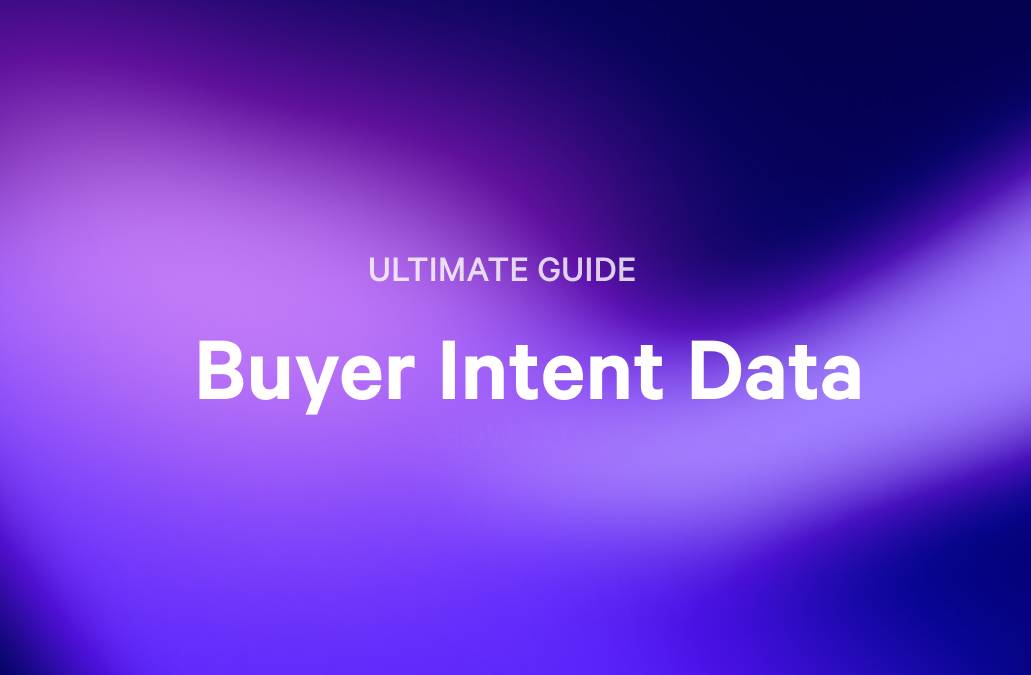Sometimes it feels as though B2B sales have become an arms race for complexity. In response to increasingly complicated buying processes and ever larger buying teams on the customer side, sales and marketing professionals are creating omnichannel webs of touchpoints and AI-driven automated sequences to meet every possible buying scenario.
It’s surprising how quickly you can lose sight of the importance of friction-free purchasing. Consequently, in this escalation of sophistication, the role of the buyer enablement champion has never been more vital.
Buyer enablement champions adopt the buyer’s POV, hunt down, and remove friction from the buying journey. This means that all sales activity is much more likely to serve the all-important bottom line.
Ironically, simplification can be a real challenge. Successful buyer enablement champions rely on a host of powerful tools to help them understand the customer experience. It's an ongoing task to find the best ways to respond to buyer interactions at every stage of the sales cycle.
We’ve put together a list of our favorite buyer enablement tools to help you keep a strong focus on the customer experience every step of the way.
Key takeaways
- Buyer enablement should be tackled one sales cycle stage at a time.
- There are two main categories of buyer enablement tools: buyer-facing content tools that directly impact the buyer experience and sales enablement-adjacent tools that help you identify and remove friction from the buyer journey.
- From next-gen AI chatbots to instant video chat functionality, there’s a host of exciting new technologies to make buying easier for prospects.
What are buyer enablement tools?
Buyer enablement tools fall into two categories. First, there are buyer-facing resources and content used to equip buyers to purchase more easily.
Buyer-facing content
Gartner provides a useful guide to the different types of this sort of enabling content.
Calculators provide a simple, structured way to quickly analyze data and compare buying options.
Diagnostic tools allow customers to assess their own performance or status.
Recommenders are a variant of calculators and diagnostic tools but usually provide a more comprehensive set of options based on the data provided by the customer.
Advisor tools provide live or automated coaching for the customer to help personalize and directly guide the buying process.
Benchmark tools allow customers to compare their position to industry standards (often based on the company’s private data sets or other hard-to-find data sources).
Simulator tools allow the customer to take the product for a trial spin. These are often combined with an advisor tool.
Buyer enablement tools are also used to remove friction from the buying journey and personalize interactions or sales collateral.
Pipeline management and analytical tools
These tools are often designed initially as sales engagement or sales enablement tools. Buyer engagement functionality is then included as an add-on to improve processes at specific stages of the sales cycle.
For example, Gong.io (one of the tools we’ve included in our round-up) is a great sales enablement tool. Gong’s AI analysis of sales conversations provides insights that allow sales teams to tailor their approach more closely to their prospects' needs and pain points.
However, these insights are equally applicable when implementing buyer enablement processes.
Gong’s use of Smart Trackers allows you to focus on themes and trends in your customer interactions. This lets you identify the concepts and questions that matter most when a customer is looking for reasons to buy.
How to choose the right buyer enablement tool
Adding another tool (and expense) to your sales tech stack isn’t something to be taken lightly. It’s important to ensure you’re doing it for the right reasons.
If you’re seriously in the market for a buyer enablement tool, ask yourself the following questions before you start exploring the solutions we’ve summarized below:
- What is the biggest hurdle your buyers experience when navigating your sales journey?
- What do you want to achieve as a result of your buyer enablement strategy?
To answer these questions fully, it may be helpful to review each stage of your sales cycle from the buyer’s perspective. Look at what’s required from their end in each stage and ask yourself if there’s an easier way.
This approach should provide you with a comprehensive overview of the issues you need to tackle through your buyer enablement strategy - it can be effective to deal with one stage at a time and then assess the subsequent changes that result before moving on to the next set of buyer challenges.
By limiting yourself to one stage of the sales cycle at a time, you’ll also get a clearer idea of which features you require from your buyer enablement tool (which is very helpful when so many of these tools are packed with features for a wide range of applications and use cases).
What are the different stages of the sales cycle?
Although different sales methodologies offer variations (and there are proven strategies to shorten or automate the cycle), the B2B sales cycle is generally composed of the following stages in the following order.
Prospecting and lead generation
Research and initial lead qualification
Outreach and seeking introductions
Presentation or making a persuasive pitch
Negotiating and handling objections
Closing the deal
Follow up
The top six buyer enablement tools in 2024
To help you assess which of our favorite buyer enablement tools is most relevant to your situation, every tool we’ve identified boasts a distinct set of benefits aligned with a particular stage of the sales cycle.
We’re describing these tools in terms of which sales cycle stage they’re suited for, the key features and benefits they can provide, and a quick overview of their pricing structure and tiers to help you assess your potential ROI.
Best for proposals and sales content: Qwilr
Qwilr transforms static proposals into captivating, interactive experiences. By giving sales professionals the freedom to instantly tailor and personalize their proposals to the specific needs and preferences of their client, Qwilr proposals and proposal software can be used to answer any additional questions or issues.
This saves the client time and allows them to buy your product with peace of mind.
Primary use case
Qwilr enables buyers at the outreach and presentation stages.
Standout features and benefits:
- Sales teams can provide everything customers need within a single interactive page, with dynamic pricing tools and ROI calculators, legally compliant e-signatures, and integrated payment functionality (through Stripe).
- Engagement tracking features (such as email alerts) give you real-time insights into the customer’s interactions with the proposal, allowing you to time and tailor your responses to their needs.
- Instantly customizable templates allow sales teams to create, edit, or rebrand bespoke proposals in a few minutes using our comprehensive Qwilr editing tools.
Pricing
Qwilr’s Business Plan costs $39 per user/month, or for $59 a month, users can enjoy features like dedicated account management and native Salesforce integration on the Enterprise Plan.
Best for lead qualification: Gong.io
Gong’s AI-driven conversation intelligence platform records, transcribes, and analyzes sales calls and meetings in real-time. This enables reps to fine-tune their approach and better address prospect concerns.
Primary use case
Gong is most applicable to buyer enablement at the research and lead qualification stage of the sales cycle.
Standout features and benefits
- Conversation Intelligence records and analyses sales calls, surfacing insights to help reps tailor sales conversations to buyer needs in real-time.
- Smart Trackers allow you to focus on key terms, themes, and trends in your customer interactions so you can identify the concepts and questions that matter most when a customer is looking for reasons to buy.
- Auto-generated searchable transcripts add every sales conversation to an ever-increasing library you can quickly mine for qualitative customer data.
- Coaching: Offers personalized feedback and coaching opportunities for sales reps, improving buyer engagement strategies.
Pricing
Gong’s pricing information is available on request.
“It’s especially helpful that you can highlight a "snippet" that is especially powerful or to reiterate the best next actions agreed to with the client. They can hear their agreement in their own words.” -- Rachel H (GetApp reviewer)
Best for personalized outreach: HubSpot Sales Hub
Sales Hub offers powerful functionality for sales teams looking to improve buyer enablement (particularly if your organization is already aligned with the HubSpot ecosystem).
Sales Hub allows reps to easily organize, track, and categorize their interactions with prospects, personalize their outreach with email templates, and automate follow-up tasks for streamlined workflow.
Primary use case
Sales Hub’s benefits are most evident at the prospecting and lead generation stages of the sales cycle.
Standout features and benefits
- ABM tools let you segment your prospects and detail roles for individual contacts, ensuring a greater level of personalization.
- Email integration lets you streamline your email processes directly from the CRM. You can also track metrics like open rate and get real-time alerts when a prospect opens an email, clicks a link, or downloads an attachment.
- CRM Integration: Centralizes buyer data and interactions for personalized engagement and seamless sales processes.
- Automated Workflows: Streamlines routine tasks, enabling sales reps to focus on buyer needs and relationship building.
- Meeting Scheduling: Simplifies the appointment setting with shared calendars and booking links, reducing friction for buyers.
- Sales pipeline management: Offers visibility into where prospects are in the buying journey, allowing for tailored communications and support.
Pricing
Sales Hub has four pricing tiers, ranging from a free package to an Enterprise plan costing $150/month per seat.
“(Sales Hub’s) ability to accurately manage our sales activity and the deal pipeline has provided us with more data that has allowed us to improve our sales processes, focus our sales activity, and close deals faster." -- Jay Perrill (Perrill Agency, Minneapolis)
Best for self-service: Drift
Any list of buyer enablement tools in 2024 would be amiss without at least one chatbot platform. We’re not the only ones choosing Drift, either. Their recent acquisition by SalesLoft is a clear indicator that Drift is at the front of an increasingly crowded pack of chatbots and self-service options.
Drift’s own research makes a convincing case for automated outreach, with 37% of sellers reporting buyers who are frustrated with online forms and scattershot engagement.
Drift’s instant responses, personalized interactions, and sales rep routing is helping sales teams across multiple industries provide great customer experience. Gong credits Drift with helping them book 44% more meetings, quarter-on-quarter.
Primary use case
Implementing Drift on your website can yield significant benefits for your buyer enablement at the lead qualification and outreach stages of the sales cycle.
Standout features and benefits
Conversational marketing - real-time, relevant conversations engage website visitors, qualify them, and quickly move them through the buying journey.
Prospector - Provides alerts when high-value accounts are on your website. You can then use Live View to connect in real-time.
Drift Analytics & Insights lets you analyze which conversational approaches generate your highest-converting leads and shows you which pages they happen on.
Pricing
Drift’s 3-tier pricing structure starts at $2,500 per month for the lowest tier (Premium), with prices for the two higher tiers available on request.
“Drift is an easy way to bring chat to your site - especially when people are less and less willing to browse your site for answers and don't trust you'll ever respond to your "contact us" form.” --Aaron J, GetApp reviewer
Best for pipeline management: Clari
Billed as a revenue operations (or RevOps) platform, Clari provides sales leaders with data-driven insights about the health of their sales pipeline. Clari identifies risks and friction points and offers reliable AI-powered forecasting to predict revenue outcomes and guide sales strategy decision-making.
Clari has a strong pedigree behind the scenes, too. Their VP of Revenue Growth and Enablement, Kyle Coleman, is considered to be ‘every SDR's best friend’ and is one of the leading voices in B2B tech sales.
Primary use case
As a pipeline management tool, Clari is used to analyze and identify risks and opportunities across the entire sales cycle, without specializing in any particular stage.
Standout features and benefits
Groove—previously a market-leading sales engagement platform in its own right, Clari’s acquisition and incorporation of Groove into their existing solution was a game changer. Groove allows sellers to create separate engagement strategies and flows for different audience segments, roles, and product lines and then automates them across email, SMS, LinkedIn, calls, and more.
Copilot - Clari’s conversation intelligence solution (another smart acquisition - Copilot was previously Wingman) provides real-time battlecards, offering reps a range of responses the moment the buyer raises an objection. Copilot also features a monologue alert to keep reps listening and include the buyer in the conversation.
Clari Forecast - Clari's endlessly adaptable forecasting solution helps sales leaders predict future revenue outcomes with accuracy. By analyzing historical data and current pipeline metrics, Clari allows sales teams to make informed decisions about resource allocation, goal setting, and strategy development. This ultimately drives better results for both the organization and the buyer.
Pricing
Available on request
"I have discovered Clari with my organization. I work as Renewal Manager and it really makes it easier to follow up with all the clients and not lose sight of them " -- Gartner reviewer
Best for scheduling: Calendly
It might seem obvious to those who’ve already implemented it, but a good scheduling tool is one of the most cost-effective ways to reduce friction and simplify buyer enablement. Applied to the right buyer journey, Calendly can instantly eliminate an entire swathe of boring early-stage back-and-forth - reducing the number of opportunities your prospect has for getting cold feet.
Primary use case
Calendly is most useful during the research stage of the sales cycle (as leads can qualify themselves by booking an appointment) or during outreach activities after contact has been made.
Standout features and benefits
Automated Scheduling - eliminates back-and-forth emails by allowing buyers to book meetings directly, aligning with your availability.
Calendly automatically adjusts for different time zones, ensuring global customers can easily schedule meetings, and personalized meeting setups cater specifically to buyer needs, enhancing the buying experience.
It syncs with your calendar to prevent double bookings and provides reminders and follow-ups, ensuring both parties are more prepared for meetings, saving time, and improving engagement.
Pricing
Calendly offers four tiers (with a generous 20% discount if you choose to pay annually). There’s a free plan available, and the paid plans range from $12 per seat/month to the Enterprise package, which starts at $15k per year.
“Scheduling appointments with clients and prospects is much easier without the need to email potential meeting times/places/methods back and forth.”-- Russell, GetApp reviewer
Best for automated sequences: Outreach
For a solid multi-channel sequence management tool, it’s hard to beat Outreach. With voice calling and LinkedIn functionality, Outreach lets you put together sophisticated personalized sequences.
AI-powered insights (generated through analyzing buyer intent data) advise on the best times and methods for contacting prospects. Their AI also helps track engagement and activity and tailor sales approach and content.
Primary use case
Outreach’s automated email and call sequences are useful in the earlier prospecting and lead generation stages, as well as the final follow-up stages of the sales cycle.
Standout features and benefits
Sequencing - Designs and automates custom touchpoint cadences to ensure consistent and timely follow-ups with buyers.
Email and Call Integration - Centralizes communications, providing reps with the context needed to personalize buyer interactions.
Engagement Tracking - Monitors buyer activity and engagement levels to help tailor the sales approach and content.
Conversation intelligence - Utilises machine learning to analyze buyer signals, recommending the best times and methods for contacting prospects.
Pricing
Pricing for Outreach’s customizable packages is available on request.
“Outreach is used to reach out to prospects and customers to provide information about our product as well as new training topics, webinars, educational information, and other important information.” -- Erin Winnicki, Regional Sales Executive, TrustRadius reviewer
Other emerging buyer enablement tools to explore
The world of sales software tools never stays still. In addition to the tried-and-tested solutions recommended above, some exciting new challenger products are coming out. One or more of these may well suit the direction of your buyer enablement strategy.
Service Bell
Service Bell allows sales teams to engage website visitors with video chat support in real-time - effectively turning any website visit into a live sales video call.
The real magic happens when you integrate with your CRM, though. Connect Service Bell to your Salesforce or Hubspot, and you’ll receive alerts when key personnel from target accounts are present on your website, allowing you to provide tailored engagement based on their known needs and preferences.
Other visitors can be de-anonymized using 6Sense and Clearbit Reveal.
Service Bell isn’t just for websites, either - you can implement its tools directly into your SaaS product, allowing you to facilitate free trials and provide product training for new customers.
Vidyard
Given the effectiveness of video as a sales and marketing tool, it’s perhaps not surprising that two of the emerging tools we’re most excited about are designed around video functionality.
Vidyard is a great choice for any team looking to bring video further down the funnel. Powerful analytics with a strong set of integrations (including a dedicated Chrome extension and an easy-to-use editor will allow your team to build trust with personalized and persuasive video messaging.
There’s a host of features, including an auto-scroll teleprompter and an AI script generator to help your reps feel relaxed and in control as they get ready for their close-up.
The generous free plan makes Vidyard a great tool choice for startups and small businesses, too.
Mixmax
This powerful sequence-builder works seamlessly across email, phone, SMS, and social media, providing tailored multi-channel communications that harness AI through real-time updates on prospect activity.
The AI Compose writing assistant and email and message templates will help increase your team’s responsiveness, along with one-click scheduling for calendar invites, meeting notifications, and reminders.
Keeping up with the needs of your buyers
No matter what buyer enablement strategy or tools you implement remember that it will always need revisiting. All markets (none more so than B2B SaaS) are constantly changing, and your buyers' needs will change, too. Anyone looking to kickstart their buyer enablement processes could take a look at these ten questions to help you review your customer-facing content.
Buyer enablement is above all a mindset, and tools like Qwilr are only useful in so far as they help you meet the buyer where they are. Want to give it a shot with some prospects in the coming weeks? Sign up for a 14-day free trial.
About the author

Dan Lever|Brand Consultant and Copywriter
Dan Lever is an experienced brand consultant and copywriter. He brings over 7 years experience in marketing and sales development, across a range of industries including B2B SaaS, third sector and higher education.
Frequently asked questions
Buyer enablement is all about the interaction between buyer and seller, as the seller tries to make the buyer’s life easier. Sales enablement is an internal process carried out by organizations where sales enablement teams try to make life easier for the sales team.
Buyer enablement is the process of providing potential buyers with resources and tools to help them make a purchase more easily. Typical tools and resources include ROI calculators, benchmarking data, case studies, and white papers.
Map out your buyers’ needs, assessing their journey through every stage of the sales cycle. Try to understand the sales process from their perspective and look for opportunities to reduce the number of tasks they have to complete to buy.


